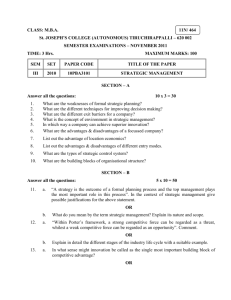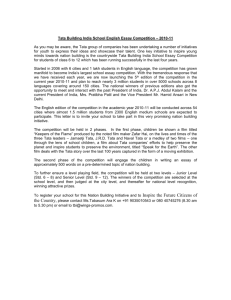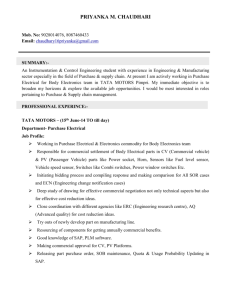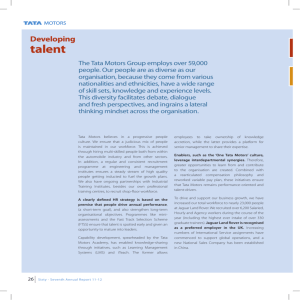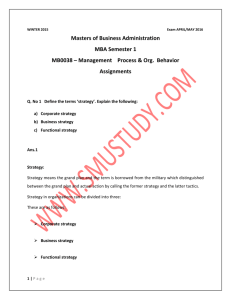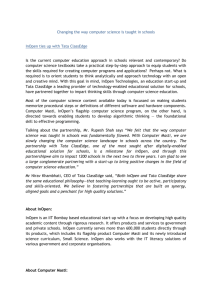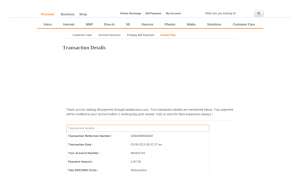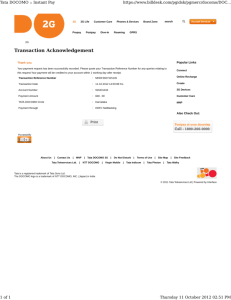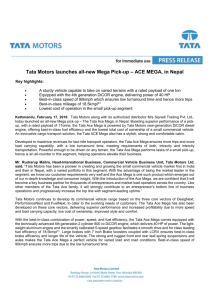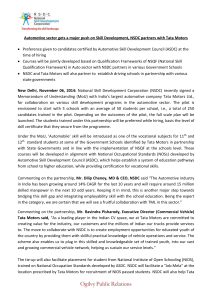Strategic planning I..
advertisement
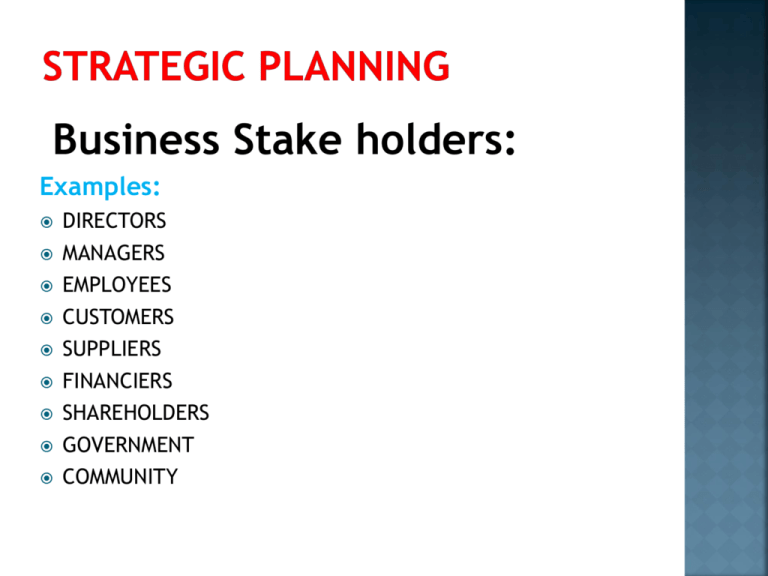
Business Stake holders: Examples: DIRECTORS MANAGERS EMPLOYEES CUSTOMERS SUPPLIERS FINANCIERS SHAREHOLDERS GOVERNMENT COMMUNITY Strategy is a “means to an end” The term “strategy” is derived from the Greek word “strategos” meaning “general”. Is the direction that the organization chooses to follow in order to fulfill it’s mission. Strategy is a well planned, deliberate and overall course of action to achieve specific objectives. Strategy is the determination of the mission (or the fundamental purpose) and the basic long-term objectives of an enterprise, and the adoption of courses of action and allocation of resources necessary to achieve these aims. Strategic planning tools 1. 2. 3. 4. 5. SWOT ANALYSIS TOWS MATRIX/ ANALYSIS BUSINESS PORTFOLIO ANALYSIS PORTER’S MODEL FOR INDUSTRY ANALYSIS CRITICAL QUESTION ANALYSIS Strategy concerns the direction in which human and material resources will be applied in order to increase the chance of achieving selected objectives. Operational Planning: Tactics To be effective, strategies and policies must be put into practice by means of plans. Tactics are the action plans through which strategies are executed. Generals Motors Roger Smith of General Motors saw the opportunities in the high-tech field and their importance for GM. He decided to acquire Electronic Data Systems Corp., a large data processing company. Reliance and Sahara Merger strategy : Examples Birla and Yamaha-motors of Japan Hindustan computers and HP Wal-Mart is an example of a company that uses the push vs. pull strategy. A push–pull system in business describes the movement of a product or information between two subjects. On markets the consumers usually "pull" the goods or information they demand for their needs, while the offerers or suppliers "pushes" them toward the consumers. Brand Strategy: A plan for the systematic development of a brand to enable it to meet its agreed objectives. The strategy should be rooted in the brand's vision and driven by the principles of differentiation and sustained consumer appeal. GROWTH STRATEGY Tata Groups strategic alliance with Japanese telecom major NTT DOCOMO in November 2008. Tata Teleservices has received a license to operate GSM telecom services in 19 of India’s 22 telecom Circles-and has also been allotted spectrum in 18 telecom circles. ACQUISITION‟S Tata company acquired company Country Stake. acquired Tata BT Groups (BT) Mosaic business UK 100 per cent in 2011. Tata Chemicals acquired British Salt UK 100 per cent (wholly-owned)2010January DIVESTMENT STRATEGY Tata Oil Mill (TOMCO) was divested and sold to Hindustan Levers as soaps and a detergent was not considered a core business for the Tata‟s. The pharmaceuticals companies of the Tata‟sMerind and Tata Parma – were divested to Wockhardt. The cosmetics company Lakme was divested and sold to Hindustan Levers, as besides being a non core business. BUSINESS LEVEL STRATEGY Tata nano, the cheapest car in the world. Swach, the cheapest water filter from Tata Chemicals costing less than Rs 1000. Tata Motors launched the Ace truck in May 2005 for just above Rs 200,000. PRODUCT DIFFERENTIATION STRATEGY Tata Motors new launches like Aria and the new 2011 Safari to regain its lost market share. Tata is looking at doubling SUV annual volumes to over 70,000 units in the next 12-18 months, including exports. Tata Motors is set to offer utility vehicles at every price point right from Rs. 6.5 lakh to Rs. 15 . I. Environmental Appraisal Is an analysis of the relevant environment that results in the identification of threats and opportunities. Environment of a company is the pattern of all external influences that affect its life and development. Every company must define its own relevant environment. Key environment factors: 1. Political and legal factors: (a) Stability of the government and its political philosophy. (b)Taxation and industrial licensing laws. (c)Monetary and fiscal policies. (d) Restrictions on capital movement, repatriation of capital, state trading, etc. 2. Economic factors: Level of economic development and distribution of personal income. Trend in prices, exchange rates, balance of payments, etc. Supply of labour, raw material, capital, etc. 3. Competitive factors: a). Identification of major competitors. b).Analysis of their performance and programs in major areas such as: market penetration, Product life-cycle, product mix, distribution channels and sales organization, servicing. Credit and delivery, advertising and promotion, pricing and branding, labor unions, training of personnel, technological development and productivity. Efficiency in manufacturing, financial strength, profitability and rate of return on sales and investment. c). Anti-monopoly laws and rules of competition. d).Protection of patents, trademarks, brand names and other industrial property rights. 4. Social and cultural factors: Literacy levels of population Religious and social characteristics. Extent and rate of urbanization. Rate of social change. II. Corporate Appraisal Involves an analysis of the company’s strengths and weaknesses. Company’s strengths may lie in: It’s outstanding leadership and excellent product design. Low-cost manufacturing skill and efficient customer service. Personnel relationship with customers, efficient transportation and logistics. Effective sales promotion, high turnover of inventories and /or capital. Ability to influence legislation, ownership of low-cost or scare raw materials. The corporate-level strategy- Executives craft the overall strategy for a diversified company Business strategies- developed usually by the general manager of a business unit Functional strategies- The aim is to support the business and corporate strategies Inputs Various organizational inputs, including the goal inputs of the claimants. Enterprise Profile The starting point for determining where the company is and where it should go. Top managers clarify the firm’s geographic orientation, such as whether it should operate in selected regions, in all states. Assess the competitive situation of their firm. Orientation of Top Managers Top managers, set the organizational climate, and they determine the direction of the firm. Their values, their preferences, and their attitudes toward risks have to be carefully examined. Present and future external environment must be assessed in terms of threats and opportunities. Evaluation focuses on economic, social, political, legal, demographic, and geographic factors. Environment is scanned for technological developments, for products and services and for other factors necessary in determining the competitive situation. Firms' internal environment should be audited and evaluated in respect to its resources and its weaknesses and strengths. Areas are: research and development, production, procurement, marketing, and products and services. Other factors include the assessment of human resources and financial resources . Also factors such as the company image, the organization structure and climate. Planning and control system, and relations with customers. Strategic alternatives are developed on the basis of an analysis of the external and internal environment. It may specialize or concentrate; the Korean Hyundai Company did by producing lowerpriced cars (in contrast to General Motors. Alternatively, a firm may diversify, extending the operation into new and profitable markets. Another strategy is to go international and expand the operation into other countries also examines joint ventures, for big undertakings in which firms have to pool their resources. Have to adopt a liquidation strategy by terminating an unprofitable product line or even dissolving the firm Retrenchment strategy may be appropriate Various strategies have to be carefully evaluated before the choice is made. Choices must be considered in light of the risks involved in a particular decision. Profitable opportunities may be pursued because a failure in a risky venture could result in bankruptcy of the firm. Critical element in choosing a strategy is timing. Medium-and Short-Range Planning, Implementation and Control : Medium- and short- range planning as well as the implementation of the plans must be considered during all phases of the process. Control must also be provided for monitoring performance against plans. Consistency and Contingency: Key aspect of the strategic planning is testing for consistency and preparing for contingency plans. Communicating strategies to all key decision-making managers. Developing and communicating planning premises. Ensuring that action plans contribute to and reflect major objectives and strategies. Reviewing strategies regularly. Developing contingency strategies and programs. Making the organization structure fit planning needs. Continuing to emphasize planning and implementing strategy. Creating a company climate that forces planning. 1. Managers are inadequately prepared for strategic planning. 2. The information for preparing the plans is insufficient for planning for action. 3. The goals of the organization are too vague to be of value. 4. The business units (a distinct form of organization) are not clearly identified. 5. The reviews of the strategic plans of the business units are not done effectively. 6. The link between strategic planning and control is insufficient.
